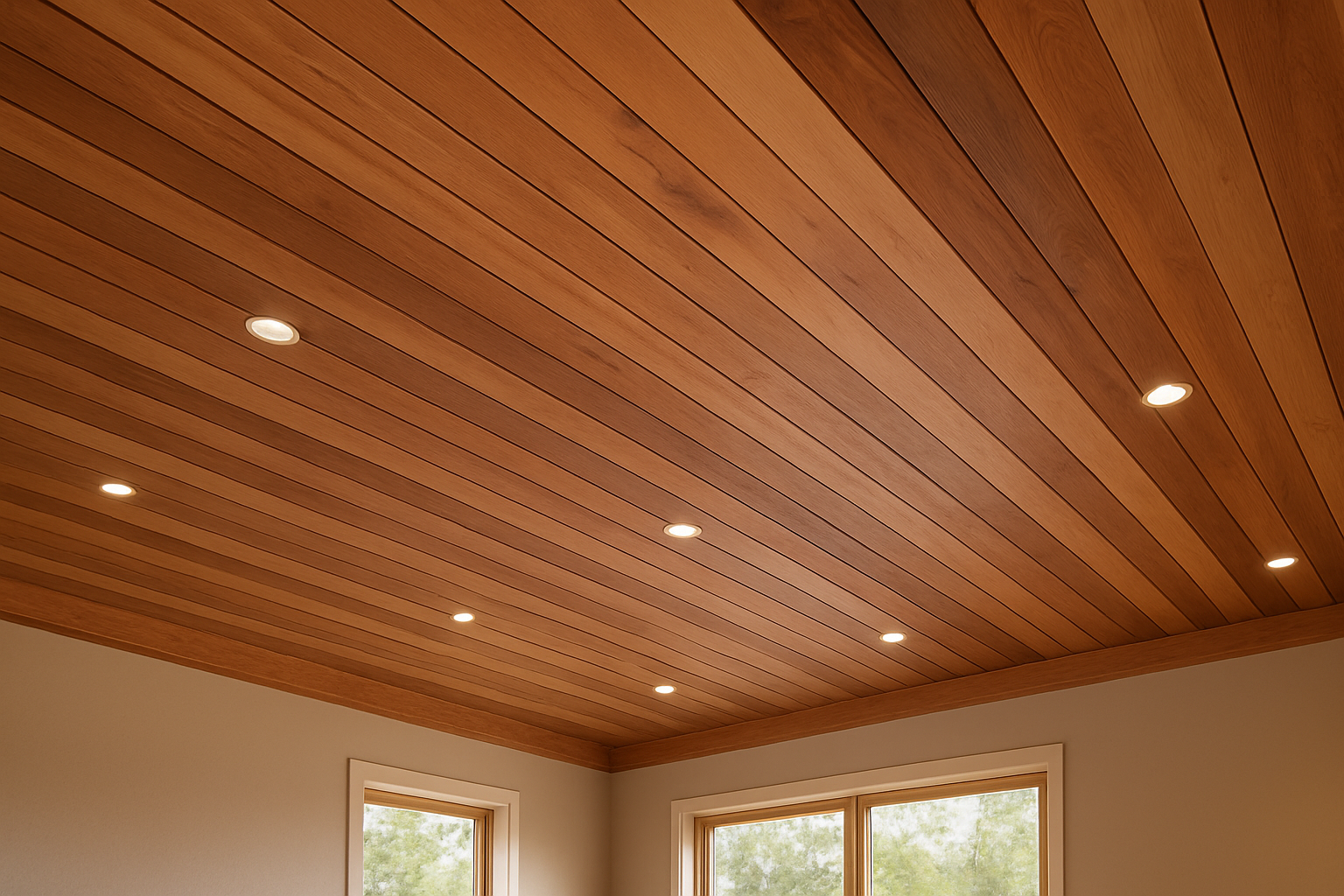In interior design, ceilings are often overlooked, yet they have the power to completely transform how a space feels. Among modern ceiling trends, the wood drop ceiling has gained attention for its mix of natural warmth, elegance, and practical functionality. Whether used in a cozy home basement or a polished corporate office, it offers a timeless look that combines style with substance.
A wood drop ceiling, sometimes called a suspended wood ceiling, consists of wood panels or planks set into a grid system below the structural ceiling. This design conceals wiring, ductwork, and pipes while maintaining easy access for maintenance. The result is a ceiling that not only looks refined but also helps organize and insulate the space above.
Homeowners, architects, and designers are turning to wood drop ceilings because they balance modern aesthetics with traditional charm. They bring a sense of warmth that complements almost any décor style — from rustic cabins and contemporary apartments to high-end restaurants. More than just visual appeal, they also deliver real-world benefits such as improved acoustics, temperature regulation, and durability.
What Is a Wood Drop Ceiling?
A wood drop ceiling is a suspended system designed to hang slightly below the actual ceiling structure. It is made using a grid of lightweight metal tracks that hold wooden tiles or panels in place. This creates an elegant secondary ceiling layer that hides unsightly components like wiring, vents, and pipes, while still allowing easy access for repairs or upgrades.
Unlike traditional acoustic or metal drop ceilings, which often feel cold or industrial, wood drop ceilings introduce texture and personality. They can be crafted from solid wood, veneer panels, or engineered wood depending on the project’s budget and design goals. Many homeowners prefer real hardwood panels for their authenticity, while commercial spaces often use veneered MDF or laminate alternatives to reduce cost and weight.
The key advantage of a wood drop ceiling lies in its combination of form and function. It not only covers the ceiling infrastructure neatly but also contributes to a room’s character. The natural tones of wood help soften the space, making it feel more inviting and cohesive.
Design Appeal: How Wood Drop Ceilings Transform a Space
One of the strongest reasons designers love wood drop ceilings is their ability to transform atmosphere. The moment wooden panels are introduced overhead, they add warmth and depth that few other materials can replicate. Whether in a living room, an office, or a hotel lobby, the texture of wood brings nature indoors, creating a calm and grounded environment.
The ceiling often becomes a focal point — a visual anchor that balances the entire room. In modern interiors, where minimalist lines dominate, the gentle grain of wood adds just enough visual interest without overpowering the décor. In rustic or farmhouse settings, wood ceilings emphasize coziness and authenticity, blending perfectly with exposed beams and earth-toned finishes.
Light also plays a key role. Depending on the wood type and finish, light can reflect softly or absorb into the surface to create mood. A matte oak panel diffuses light naturally, while a glossy walnut surface enhances sophistication. This adaptability is what makes the wood drop ceiling so versatile — it can look casual or elegant, contemporary or traditional, depending on the finish and setting.
Popular Wood Types and Finishes for Drop Ceilings
Choosing the right wood type is central to achieving the desired look and performance from a wood drop ceiling. Different species vary in color, grain, and durability, offering flexibility for any design vision.
Best Wood Types to Mention
- Oak is among the most popular choices due to its strength and visible grain pattern. It carries a timeless charm and suits both classic and transitional interiors. Oak panels also accept stains easily, allowing homeowners to adjust color tones to match their furniture and flooring.
- Maple offers a light, creamy tone with a smooth texture that complements modern or Scandinavian interiors. It reflects natural light well, making small spaces appear brighter and more open.
- Walnut adds a luxurious touch with its deep brown hue and fine grain. It’s often used in upscale homes, offices, and hospitality spaces where elegance is key. Its natural darkness helps create contrast with lighter walls or furniture.
- Pine remains a favorite for its affordability and soft, natural look. Its subtle knots and golden tones give spaces a relaxed, homely feel — ideal for basements, cottages, or family rooms.
- Cedar is known for its pleasant aroma and moisture resistance, making it a smart choice for bathrooms or humid environments. Its rich reddish tint and natural oils add both beauty and protection.
Each of these woods offers a unique aesthetic and performance quality, making the selection process an exciting part of ceiling design.
Best Finishes to Mention
Beyond the species, the finish of a wood drop ceiling greatly influences its overall look.
- A natural clear coat enhances the authentic grain of the wood while offering protection against scratches and wear. It’s perfect for homeowners who love the unaltered beauty of natural wood.
- A matte or satin finish provides a soft sheen that feels contemporary and blends well with most lighting environments. These finishes are common in both residential and commercial applications because they maintain warmth without glare.
- A stained finish — such as walnut, honey, or espresso — adds depth and tone variation. It allows customization to coordinate with other wooden elements in the room, such as furniture or flooring.
- For a lighter, airy vibe, whitewashed or graywashed finishes soften the wood’s natural color while preserving its texture. These finishes are popular in modern coastal, Nordic, or minimalist designs, adding brightness and freshness to the ceiling plane.
The combination of the right wood species and finish can dramatically change how a room feels — from cozy and rustic to sleek and contemporary.
Installation Basics: How Wood Drop Ceilings Are Built
While professional installation is recommended for best results, understanding the process helps appreciate the craftsmanship behind every wood drop ceiling. The installation begins with the setup of a metal or wooden grid system attached to the main ceiling joists. This grid creates a stable framework for the wood panels or planks to rest securely.
Once the framework is in place, wooden panels are measured, cut, and fitted within the grid. Some designs use tongue-and-groove connections, while others rely on clips or suspension hooks. Proper alignment is essential to maintain even spacing and clean lines.
Lighting fixtures, air vents, and sprinkler systems can be integrated seamlessly into the grid, allowing easy access when maintenance is required. The beauty of this system is its flexibility — panels can be removed or replaced individually without disturbing the entire ceiling.
Sound insulation material or acoustic backing is sometimes added between the structural ceiling and wood panels to improve sound control and temperature stability. The final result is a ceiling that looks polished and functions efficiently.
Acoustic and Insulation Benefits of Wood Drop Ceilings
A well-designed wood drop ceiling offers more than visual appeal — it can also improve comfort through better sound and thermal control. Wood, by nature, has excellent acoustic properties. It absorbs and diffuses sound waves rather than reflecting them harshly, which helps reduce echo and noise levels in busy rooms or open offices.
This makes wood drop ceilings a popular choice in places like restaurants, conference rooms, and home theaters, where clear sound and a calm ambiance are desired. When combined with acoustic insulation above the panels, the ceiling can significantly enhance soundproofing between floors.
Thermally, wood acts as a mild insulator. It helps maintain stable room temperatures by trapping a layer of air between the suspended panels and the original ceiling. This can reduce heating and cooling demands slightly, contributing to energy efficiency and comfort all year round.
Maintenance and Longevity: Keeping Your Wood Ceiling Beautiful
With minimal care, a wood drop ceiling can last for decades while retaining its charm. Regular maintenance mainly involves dusting and gentle cleaning. A soft cloth or duster can remove surface debris, while occasional wiping with a slightly damp cloth keeps panels fresh.
It’s important to maintain indoor humidity at balanced levels — excessive moisture can cause wood to warp, while overly dry air might lead to minor cracks. Applying a protective sealant every few years can help preserve the finish, especially in areas exposed to humidity or temperature changes.
If a panel becomes damaged or discolored over time, it can easily be replaced thanks to the modular structure of the drop ceiling. This makes wood drop ceilings not only stylish but also practical for long-term use.
Cost Factors and Value Considerations
The cost of a wood drop ceiling varies depending on materials, design complexity, and installation requirements. On average, homeowners can expect to spend between $10 and $30 per square foot, including labor. Real hardwood panels generally cost more, while veneer or laminate options provide similar aesthetics at lower prices.
Custom finishes, acoustic backing, and integrated lighting can increase the overall price, but they also add functionality and aesthetic value. Although the initial investment may be higher than basic ceiling materials, wood drop ceilings offer lasting value. They elevate the overall appearance of a space, improve resale potential, and require minimal long-term maintenance.
For many property owners, the decision is not just about cost — it’s about quality and longevity. The natural warmth and durability of wood often make it worth the investment compared to temporary or less durable alternatives.
Design Inspiration: Where Wood Drop Ceilings Work Best?
The flexibility of a wood drop ceiling allows it to complement a wide variety of interiors. In residential spaces, it adds cozy character to living rooms, home offices, and basements. The subtle grain patterns create visual interest overhead without overwhelming the décor.
In modern kitchens, light maple or whitewashed wood ceilings pair beautifully with neutral cabinetry and metal accents, creating a clean and inviting look. For open-concept living areas, darker walnut or oak ceilings add contrast and help visually define zones such as dining or lounge areas.
Commercial spaces also benefit from this ceiling type. Restaurants and cafés often use cedar or pine panels to establish a welcoming, organic feel. Corporate offices and hotels prefer sleek, stained finishes to convey professionalism and sophistication. Even art galleries and studios incorporate wood ceilings to warm up otherwise minimal environments.
Eco-Friendly and Sustainable Choices in Wood Drop Ceilings
Sustainability has become a top consideration in modern construction, and the wood drop ceiling fits well into this movement. Many manufacturers now source wood from responsibly managed forests certified by organizations such as the Forest Stewardship Council (FSC). Choosing these products ensures that the wood comes from renewable, environmentally friendly sources.
Engineered wood and veneer panels are also sustainable choices because they make efficient use of natural materials, reducing waste. Some systems even incorporate recycled wood or bamboo, which grows rapidly and offers comparable durability.
Low-VOC finishes and water-based coatings can further minimize environmental impact, maintaining healthy indoor air quality. For homeowners and businesses aiming to meet green building standards, a sustainable wood drop ceiling is both an aesthetic and ethical choice.
Conclusion: Bringing Natural Warmth and Functionality Together
A wood drop ceiling brings together beauty, function, and long-term value in one elegant package. It transforms plain ceilings into architectural highlights that express warmth, texture, and craftsmanship. Beyond appearance, it improves acoustics, conceals mechanical systems, and enhances energy efficiency — all while offering easy maintenance and design flexibility.
Whether you’re redesigning a living space or developing a commercial interior, wood drop ceilings offer a balance of sophistication and practicality. Their ability to blend seamlessly into various design styles makes them a timeless investment. As sustainability, comfort, and style continue to define modern interiors, the wood drop ceiling remains a smart, enduring choice that reflects both natural beauty and thoughtful design.
My name is Mustafa, and I have been blogging for over 5 years. I am passionate about sharing complete, accurate, and helpful information with my readers. Along with managing content on The Matcha Read, I also contribute blog posts to premium websites. My goal is to provide valuable insights in a clear and easy-to-understand way, so every reader walks away with useful knowledge.










